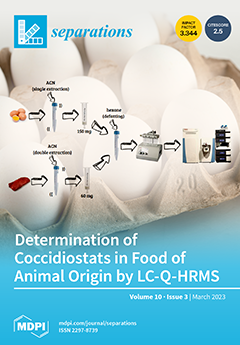Separations, Volume 10, Issue 3 (March 2023) – 76 articles
Coccidiosis is a very contagious disease that may result in economic losses, especially in intensive farms.
The development of multi-residue methods that are able to determine regulated compounds is still quite challenging, owing to their different physicochemical properties and the LODs that have to be reached. LC-MS/MS is currently the most used technique for their determination in feed and food. To the best of our knowledge, these analytes have only been determined in three cases by means of HRMS. The present work was carried out to obtain fit for purpose LODs and the highest possible selectivity of a method for the determination of coccidiostats in eggs and muscle with LC-Q-Orbitrap, performing parallel reaction monitoring (PRM) acquisition for the first time. Moreover, a full validation study was carried out according to CIR (EU) 2021/808. View this paper
- Issues are regarded as officially published after their release is announced to the table of contents alert mailing list.
- You may sign up for e-mail alerts to receive table of contents of newly released issues.
- PDF is the official format for papers published in both, html and pdf forms. To view the papers in pdf format, click on the "PDF Full-text" link, and use the free Adobe Reader to open them.





